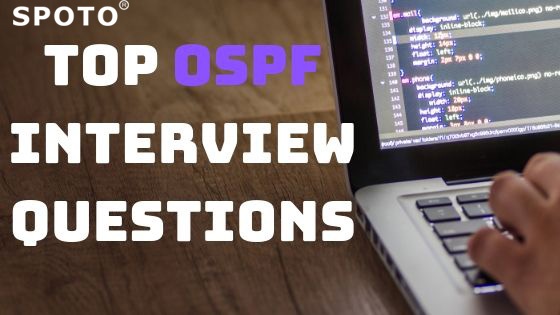Today, we will introduce the top 10 commonly asked OSPF interview questions and answers. It will help you to prepare for a job interview related to networking better.
1. What is OSPF?
OSPF is a standardized Link-State routing protocol, designed to scale efficiently to support larger networks.
2. What is the algorithm used by OSPF?
OSPF uses the OSPF (Shortest Path First) algorithm for calculating the best path and preparing the OSPF database.
3. Briefly explain functioning and working of different OSPF?
Following are working and functioning of OSPF
OSPF employs a hierarchical network design using Areas.
OSPF forms neighbor relationships with adjacent routers in the same area.
Instead of advertising the distance to connected networks, OSPF advertises the status of directly connected links using Link-State Advertisements (LSAs).
OSPF sends updates (LSAs) when there is a change to one of its links, and will only send the change during the update. LSAs are additionally refreshed every 30 minutes.
OSPF uses the Dijkstra Shortest Path First algorithm to determine the shortest path.
OSPF is a classless protocol, and thus supports VLSMs.
4. What Is the Backbone Area?
While configuring multi-area OSPF, one area must be called area 0, referred to as backbone area. All other areas must connect to backbone area as inter-area traffic is sent through the backbone area.
5. What Is OSPF Router Id?
Router Id is used to identify the Router. The highest IP address of the router's loopback interfaces is chosen as the Router ID, If no loopback is present than highest IP address of the router's physical interfaces will be chosen as the Router ID.
6. How OSPF Dr & Bdr Is Elected?
The router with the highest priority becomes the DR and router with the second-highest priority becomes the BDR. If there is a tie in priority, the router with the highest Router ID will become DR.
By default priority on Cisco routers is 1. We can manually change it.
If the Router priority is set to 0 (Zero), that router will not participate in DR/BDR election.
DR election process is not preemptive. If a router with a higher priority is added to the network, it will not become DR until we clear the OSPF process and DR/BDR election takes place again.
Command to change the priority on an interface
router(config)# interface fa0/0
router(config-if)# ip OSPF priority 100
7. Why Dr. And Bdr Are Elected In OSPF?
All OSPF routers will form adjacencies with the DR and BDR. If link-state changes, the update will be sent only to the DR, which then forwards it to all other routers. This greatly reduces the flooding of LSAs, therefore, conserving the bandwidth.
8. Explain OSPF Lisa, Lsu, And Lsr?
The LSAs (Link-State Advertisements) are used by OSPF routers to exchange routing and topology information. When two neighbors decide to exchange routes, they send each other a list of all LSA in their respective topology database. Each router then checks its topology database and sends Link State Request (LSR) message requesting all LSAs that was not found in its topology table. Other router responds with the Link State Update (LSU) that contains all LSAs requested by the neighbor.
9. What Are Different OSPF LSA Types?
Router LSA (Type1) - Each router generates a Type 1 LSA that lists its active interfaces, IP addresses, neighbors and the cost. LSA Type 1 is flooded only within an area.
Network LSA (Type2) - Type 2 LSA is sent out by the designated router (DR) and lists all the routers on the segment it is adjacent to. Type 2 LSA are flooded only within an area. It contains information about DR's.
Summary LSA (Type3) - Type 3 LSAs are generated by Area Border Routers (ABRs) to advertise networks from one area to the rest of the areas in Autonomous System. It contains information about inter-area routes.
Summary ASBR LSA (Type4) - It is generated by the ABR and contains routes to ASBRs.
External LSA (Type5) - External LSAs are generated by ASBRs and contain routes to networks that are external to current AS.
Not-So-Stubby Area LSA (Type7) - Stub areas do not allow Type 5 LSAs. A Not So Stubby Area (NSSA) allows advertisement of Type 5 LSA as Type 7 LSAs. Type LSA is generated by an ASBR inside a Not So Stubby Area (NSSA) to describe routes redistributed into the NSSA.
10. What problems can cause OSPF neighborship in “down” state?
Steps in forming neighborship in OSPF is almost similar to EIGRP’s. Two OSPF devices should be connected back to back with cables connected on correct interfaces. IP and mask should be correct. Then run the OSPF process if not run already and advertise the interface segments on both routers. Hello, Dead timers and MTU size should be same at both ends. There should not be any access-list or transparent firewall blocking the OSPF Packets or IP addresses. Neighborship should establish now. Area number and authentication parameters must match. If issues are still there, then check the router logs and try to analyze the problem.
Note: if you are interested in OSPF technology, and you can follow SPOTO.
More you may be interested:
1. How to Prepare CCNP Security Certification Exam?
2. How to Prepare the CCNP Service Provider Written Certification Exam?
3. How to Prepare the CCNP Wireless Certification Exam?
4. How to Prepare CCNP Data Center Written Certification Exam?

 Join Telegram Study Group ▷
Join Telegram Study Group ▷














